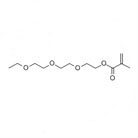What is Ethyl Tri Glycol?
Ethyl triglycol (also known as ethoxy triglycol; triethylene glycol monoethyl ether; and TGEE) has the formula C8H18O4 and is an ethoxy alcohol derivative. It is an odourless, colourless, and viscous liquid that is water soluble and is also hygroscopic. It also has a high boiling point of 256oC and a slow evaporation rate.

How is it produced?
Ethyl triglycol is produced in a closed, continuous process by the reaction of ethanol with ethylene oxide in the presence of a catalyst. It is then purified, via distillation, to form the final product. Diethylene glycol monoethyl ether and ethylene glycol monoethyl ether are also co-products of this reaction.
How is it stored and transported?
Triethylene glycol monoethyl ether has a flashpoint of 132oC (closed cup), a specific gravity of 1.02 and is not classified as hazardous for transportation. It should be transported in carbon, steel or stainless steel tanks and should then be stored in a cool, dry, and well-ventilated area. The container should be resealed after use and should be kept upright. Ethyl triglycol should be stable if stored in recommended conditions.
What is Ethyl Tri Glycol used for?
The majority of Ethyl triglycol is consumed in hydraulic and brake fluids. This is because the viscosity of ethyl triglycol remains largely constant when temperatures fluctuate, and also because of its high boiling point (256oC).
Triethylene glycol monoethyl ether is also utilised as both a chemical process solvent and as a chemical intermediate in the production of esters used as plasticisers, surfactants, and solvents. It is also employed as a solvent in the manufacture of protective coatings, adhesives, wood stains and varnish, paint strippers and in household and industrial cleaning formulations.
Ethyl triglycol is also employed in the textile industry where it acts as a dye carrier in textile dyeing processes and it also acts as a coupling agent for resins and dyes in other water-based printing inks. Ethyl triglycol is also utilised as a solubilizer for incompatible liquids in the production of insecticides and is also employed in the detergent industry in hand-wash pastes.
It is this variety of applications that means many of us are in contact with Ethyl triglycol on a regular basis. Household products which may contain Ethyl triglycol include disinfectants, surface cleaners, paint, paint strippers, floor polish, marker pens, and automotive brake fluid.



